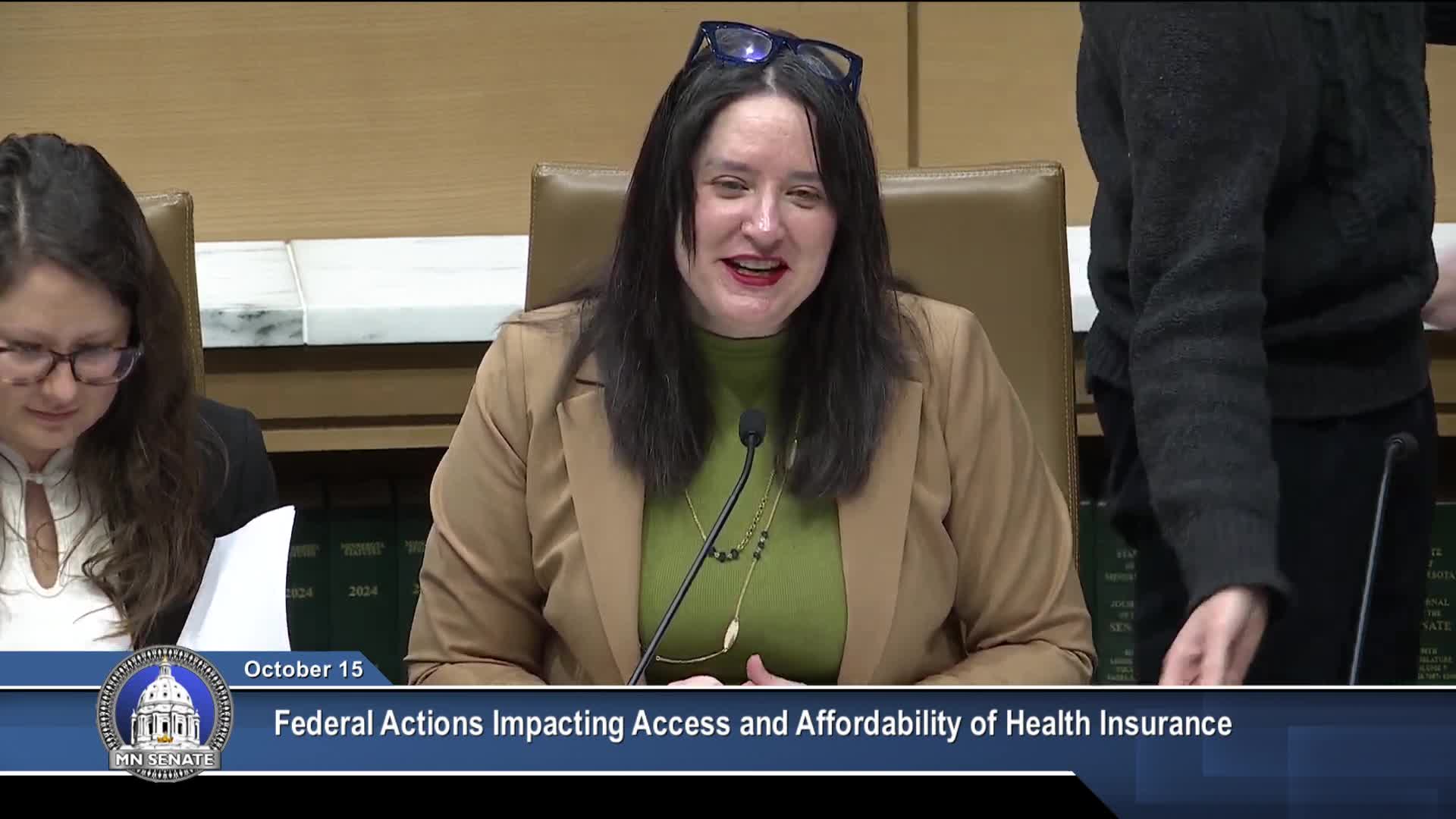Minnesota hospitals warn federal subsidy cuts and Medicaid changes could add hundreds of millions in uncompensated care and threaten rural services
October 13, 2025 | 2025 Legislature MN, Minnesota
This article was created by AI summarizing key points discussed. AI makes mistakes, so for full details and context, please refer to the video of the full meeting. Please report any errors so we can fix them. Report an error »

Mary Krenke and Joe Schindler of the Minnesota Hospital Association presented a state-level estimate of the financial effects hospitals would face if federal marketplace subsidies end and HR 1’s Medicaid-related changes proceed.
Krenke said the association used a DHS estimate that roughly 60,000 Minnesotans could be priced out of marketplace coverage if enhanced premium tax credits are not extended. The association’s conservative estimate is that hospitals would see about $115 million annually in additional charity care and $161 million in lost payments tied directly to those 60,000 people — a combined roughly $276 million hit to hospitals statewide.
Joe Schindler, the association’s vice president of finance, walked the committee through the assumptions behind those numbers: the association estimated that 40% of the newly uninsured would seek care in emergency departments (an average ER encounter estimated at about $2,500), some would be hospitalized (an average inpatient stay estimated at about $9,800), and others would be treated in clinics — together producing the $115 million charity-care estimate tied to the marketplace subsidy loss.
Krenke and Schindler also described the potential consequences of HR 1’s Medicaid provisions. They cited a DHS estimate that 140,000 Minnesotans could lose Medicaid eligibility under the bill’s new verification and work‑related rules. The association estimated that Medicaid losses could add roughly $269 million a year in uncompensated care and another $354 million in lost Medicaid payments, for a combined impact approaching $623 million annually if both changes occur.
The witnesses emphasized the geographic skew of the effects: rural hospitals would likely feel the greatest immediate pressure because small businesses and self‑employed people are a larger share of rural individual-market enrollment and because many rural hospitals already operate on thin or negative operating margins. Krenke said 40% of Minnesota hospitals had negative operating margins in the past year and that 77% of hospitals with negative margins are in rural Minnesota.
Xander Abbott, president and CEO of Northfield Hospital & Clinics, described his facility’s exposure to the same pressures. He said Northfield — a 37‑bed community hospital with five clinics — expects several percentage points of net‑revenue decline from combined effects and warned that service reductions (clinics, obstetrics, ambulance subsidies, mental‑health services) often follow when institutions face sustained revenue losses.
Krenke and Schindler also noted immediate changes already in effect: the reduction in federal reimbursement for Emergency Medical Assistance from 90% to 50% as of October 1 (a cut the association estimated would cost hospitals about $13 million annually). The testimony also raised concern about the phasing down of directed‑payment programs and disproportionate share (DSH) funding uncertainty, both of which affect safety‑net hospitals.
The subcommittee did not adopt formal actions. Committee members asked the association for supporting data and county-level operational information to inform state and legislative planning.
Krenke said the association used a DHS estimate that roughly 60,000 Minnesotans could be priced out of marketplace coverage if enhanced premium tax credits are not extended. The association’s conservative estimate is that hospitals would see about $115 million annually in additional charity care and $161 million in lost payments tied directly to those 60,000 people — a combined roughly $276 million hit to hospitals statewide.
Joe Schindler, the association’s vice president of finance, walked the committee through the assumptions behind those numbers: the association estimated that 40% of the newly uninsured would seek care in emergency departments (an average ER encounter estimated at about $2,500), some would be hospitalized (an average inpatient stay estimated at about $9,800), and others would be treated in clinics — together producing the $115 million charity-care estimate tied to the marketplace subsidy loss.
Krenke and Schindler also described the potential consequences of HR 1’s Medicaid provisions. They cited a DHS estimate that 140,000 Minnesotans could lose Medicaid eligibility under the bill’s new verification and work‑related rules. The association estimated that Medicaid losses could add roughly $269 million a year in uncompensated care and another $354 million in lost Medicaid payments, for a combined impact approaching $623 million annually if both changes occur.
The witnesses emphasized the geographic skew of the effects: rural hospitals would likely feel the greatest immediate pressure because small businesses and self‑employed people are a larger share of rural individual-market enrollment and because many rural hospitals already operate on thin or negative operating margins. Krenke said 40% of Minnesota hospitals had negative operating margins in the past year and that 77% of hospitals with negative margins are in rural Minnesota.
Xander Abbott, president and CEO of Northfield Hospital & Clinics, described his facility’s exposure to the same pressures. He said Northfield — a 37‑bed community hospital with five clinics — expects several percentage points of net‑revenue decline from combined effects and warned that service reductions (clinics, obstetrics, ambulance subsidies, mental‑health services) often follow when institutions face sustained revenue losses.
Krenke and Schindler also noted immediate changes already in effect: the reduction in federal reimbursement for Emergency Medical Assistance from 90% to 50% as of October 1 (a cut the association estimated would cost hospitals about $13 million annually). The testimony also raised concern about the phasing down of directed‑payment programs and disproportionate share (DSH) funding uncertainty, both of which affect safety‑net hospitals.
The subcommittee did not adopt formal actions. Committee members asked the association for supporting data and county-level operational information to inform state and legislative planning.
View full meeting
This article is based on a recent meeting—watch the full video and explore the complete transcript for deeper insights into the discussion.
View full meeting
